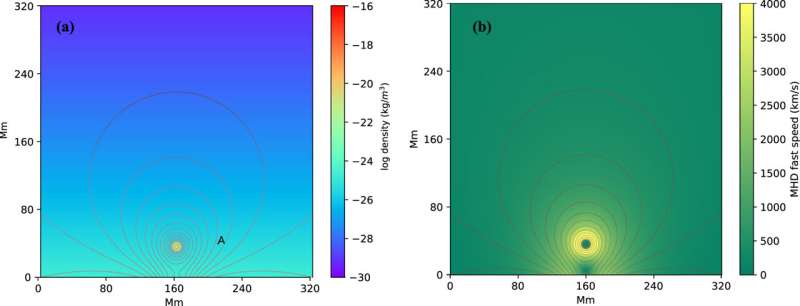Initial distributions of (a) the plasma density and (b) fast speed. The black solid curves are the magnetic field lines and point A in (a) is selected for analyzing the period of the QFP. Credit: The Astrophysical Journal (2024). DOI: 10.3847/1538-4357/ad1993
In a recent study published in The Astrophysical Journal, Hu Jialiang and Prof. Lin Jun from Yunnan Observatories (YNAO) of the Chinese Academy of Sciences and their collaborators proposed a new mechanism for the generation of large-scale quasiperiodic fast-propagating (QFP) magnetoacoustic waves on both sides of coronal mass ejection (CME).
The magnetized solar atmosphere, a highly structured medium, supports various types of wave generation and propagation. The quasi-periodic wave trains in the corona (QFP waves) are coronal disturbance phenomena observed by the Atmospheric Imaging Assembly (AIA) on the Solar Dynamics Observatory (SDO). These wave fronts, interpreted as fast-mode magnetoacoustic waves, consist of continuous, narrow arc structures, capable of rapid propagation at speeds up to 1416 km/s.
Based on current observational constraints, the origin of QFP waves remains unclear. Numerous mechanisms have been proposed to explain the relationship between CMEs or flares and QFP waves, but a definitive conclusion has yet to be reached. This study sheds new light on the origin of QFP waves.
Numerical simulations revealed that magnetic flux rope containing helical magnetic structures exhibits waveguide properties. When surrounding coronal magnetic structures destabilize, oscillations occur within the flux rope. Since the magnetic flux rope is not a perfect waveguide, the internal oscillations propagate to the boundaries and partially leak into the surrounding corona, forming the observed QFP waves.
To gain a deeper understanding of the origin of QFP waves, the researchers analyzed the propagation characteristics of disturbances by calculating velocity divergence at different times, yielding results consistent with observations.
Furthermore, synthetic images based on simulated data in extreme ultraviolet and white light highly reproduced actual observational results. This consistency of the simulation result with observation demonstrated that the leakage of internal disturbances from the flux rope, acting as a waveguide, forms a multi-wavefront structure and represents a reasonable mechanism for the generation of QFP waves.
More information: Jialiang Hu et al, Excitation of Quasiperiodic Fast-propagating Waves in the Early Stage of the Solar Eruption, The Astrophysical Journal (2024). DOI: 10.3847/1538-4357/ad1993
Provided by Chinese Academy of Sciences
























